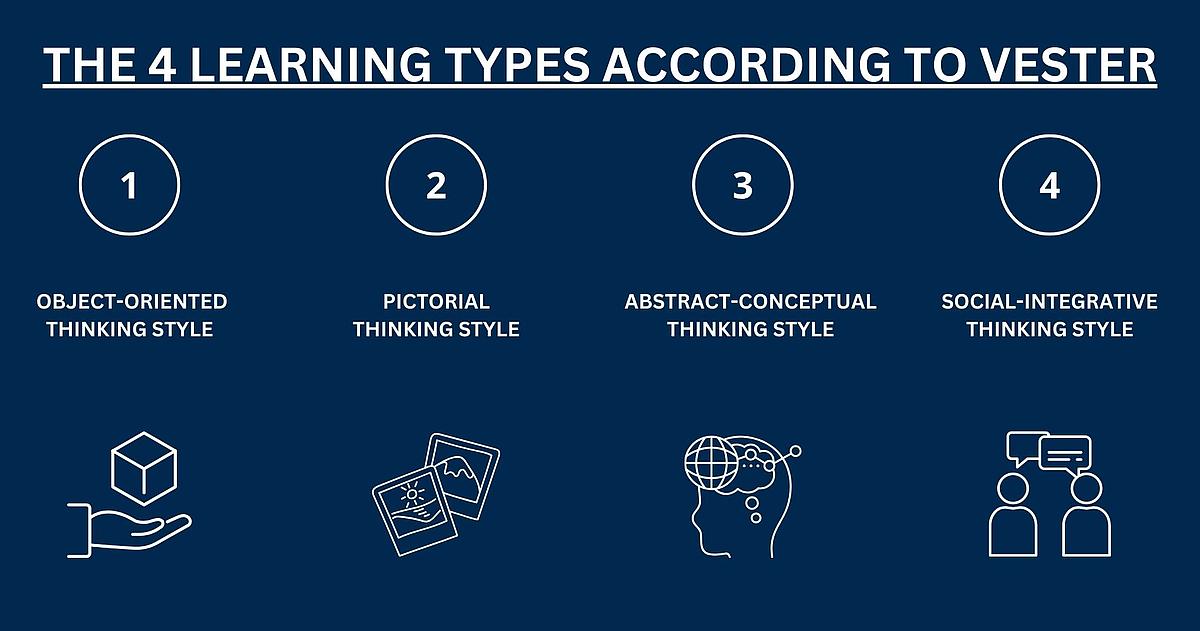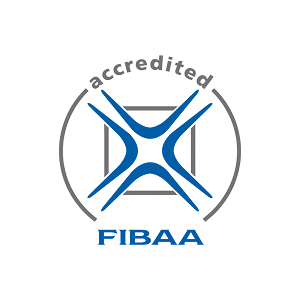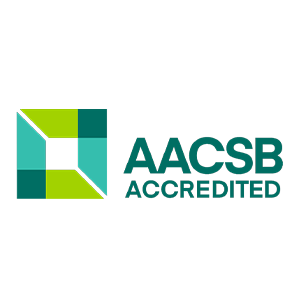This Website uses cookies to improve your visit on our website. More Info
Learning types: Which one are you and how does it help you study?
In a world that is constantly evolving, learning has become a lifelong process. However, not everyone learns in the same way. The theory of different learning types, which states that people process information better when it is presented in a certain way, has become essential in educational institutions and vocational training. In this article, we explore the different types of learners and discuss how understanding these types can help to make study strategies more effective. By adapting teaching methods to the specific needs of learners, the efficiency and enjoyment of learning can be significantly increased.
Definition of learning types: What is it?
Learning types describe the different ways in which people best absorb, process and retain information. The idea behind learning types is that everyone has individual strengths and preferences when it comes to learning. By recognizing and taking these individual differences into account, education can be made more effective and personalized.
Understanding and applying these learning types can help design curricula to optimize the learning process for different individuals. However, it is important to note that the theory of learning types is also viewed critically in the scientific community, particularly in terms of the evidence for its effectiveness in improving learning outcomes.
NOTE
Learning types are not considered fully substantiated in the scientific community because there is a lack of robust, empirical evidence that clearly shows that tailoring teaching methods to specific learning types leads to improved learning outcomes. Critics also argue that categorizing learners into fixed types is an oversimplification of the multifaceted nature of human learning and ignores important dynamic aspects of the learning process.
Advantages & Disadvantages of Learning Types
Here is a clear table showing the advantages and disadvantages of using learning types in education and learning. This table shows that the use of learning types has both positive and negative aspects. It is important to take a balanced and evidence-based approach to education that utilizes the advantages without ignoring the potential disadvantages.
| Advantages | Disadvantages |
|---|---|
| Individualized learning approaches: By catering to individual preferences and strengths, learning can be personalized and potentially more effective | Lack of scientific support: Despite their popularity, there is little empirical evidence to show that learning styles lead to improved learning outcomes. |
| Increasing motivation and engagement: If learners are taught in their preferred style, they may be more motivated and engaged. | Oversimplification of the learning process: Learning types can reduce the complexity of learning and overlook important aspects such as flexible adaptability and the need for different learning methods. |
| Improving self-awareness: Learning types can help learners learn more about their own preferences and strengths, leading to self-directed learning. | Pigeonholing learning styles: Categorizing learners into fixed learning types can limit their development by preventing them from diversifying their study strategies. |
| Encouraging innovative teaching methods: Teachers and educational institutions can be encouraged to develop creative and diverse teaching approaches. | Resource demands: Developing and implementing teaching strategies based on learning types can be time and resource intensive. |
| Adaptation to diverse learning needs: By considering different learning types, lessons can be designed to meet a wide range of learning needs. | Lack of flexibility: A rigid focus on learning types can limit the ability to adapt to different learning situations. |

Research results: Why
learning types are controversial

Learning types are controversial
| Lack of empirical support | One of the main criticisms of learning type theory is the lack of solid, empirical evidence showing that tailoring teaching methods to students' preferred learning types leads to better learning outcomes. Studies that have attempted to evaluate the effectiveness of teaching methods based on learning types have often produced inconsistent or non-significant results. |
|---|---|
| Myth of learning styles | The theory of learning types often relies on the so-called meshing hypothesis, which states that learning is improved when the teaching method matches a student's preferred learning type. However, systematic reviews and meta-analyses have found little support for this hypothesis. Researchers such as Harold Pashler and colleagues have argued that there is inadequate evidence to support the effectiveness of teaching methods that are matched to learning types. |
| Oversimplification of the learning process | Critics argue that categorizing learners into specific types (such as visual, auditory, kinesthetic) is an oversimplification of the complexity of human learning. Learning is a dynamic process that is influenced by a variety of factors, including cognitive, emotional and social aspects. Focusing on learning types can overlook other important elements of the learning process. |
| Fixation on static categories | Categorizing individuals into fixed learning types can limit the perception of flexibility and adaptability in learning behavior. People are often able to change their study strategies depending on the situation and type of learning material. The assumption that every learner can be assigned to a specific type may therefore be too rigid. |
| Newer approaches and nuances | Recent research suggests a more nuanced view of learning preferences that goes beyond the simple categories of traditional learning types. There are suggestions that a more comprehensive look at individual differences in cognition and motivation may be more useful. |
The debate about learning types and their scientific validity is widespread in educational research and psychology. While the idea of learning types is very popular in popular education, many scientists and education experts view it critically for the reasons above. Due to these criticisms, many educational researchers and psychologists recommend that teaching methods should be broadly and adaptively designed to support all learners regardless of their supposed 'learning type'. They emphasize the need to use evidence-based practices that are grounded in sound science.
What learning types are there?: The 4 learning types
The four typical learning types - visual, auditory, kinaesthetic and reading/writing - were largely popularized by Neil D. Fleming in the late 1980s. He coined the VARK model (Visual, Aural, Read/Write, Kinesthetic), which describes these four main learning styles. Fleming's model has become a widely used tool in education to help better understand and support the different ways in which people learn.
Overview of Learning Types: The 4 Learning Types
The following graphic provides a brief overview of the 4 learning types that are frequently mentioned.

Explanation: The 4 Learning Types
Each of these learning types has its own strengths and preferred methods that can make the learning process more effective if used correctly. However, it is important to have a flexible approach to learning and to integrate different methods to cover all aspects of the subject matter.
Visual Learner Type
Visual learners absorb information best when they can see it. They prefer graphics, diagrams, pictures, films and other visual media.
Auditory Learner Type
Auditory learners understand and retain information better when they hear it. They benefit from lectures, discussions and audio-based media.
Kinesthetic or Tactile Learner Type
Kinesthetic learners prefer hands-on experiences and activities where they can physically interact with the learning material. They learn by doing and direct engagement.
Reading/ Writing Learner Type
These learners prefer to interact with written words. They find that they process information best by reading and writing text.
Learning Types according to Vester
Frederic Vester, a German biochemist and environmental expert, developed a model of learning types that focuses on cognitive and psychological aspects of learning. His approach differs from other learning type models in that it focuses more strongly on thinking styles and information processing.
Overview of Learning Types: The four Learning Types according to Vester
The following graphic provides a brief overview of the four learning types according to Vester. Vester identified four learning types, which he described as “thinking styles”.

Explanation: The four Learning Styles according to Vester
Vester's concept of thinking styles highlights the diversity of cognitive processes involved in learning and emphasizes the importance of adapting teaching methods to learners' individual cognitive strengths. This approach supports a diversified education that aims to adapt the learning environment to students' natural preferences and abilities in order to maximize their learning success.
The object-oriented Thinking Style
These individuals prefer to work with concrete, tangible objects and situations. They learn best through direct interaction with the physical world and prefer hands-on activities and experiments.
The pictorial Thinking Style
Individuals with a pictorial thinking style prefer visual information and learn effectively through pictures, graphics and spatial representations. They often have a strong imagination and are good at memorizing visual concepts.
The abstract-conceptual Thinking Style
These learners prefer theoretical information and concepts. They are good at logical thinking and dealing with abstract models and theories. They tend to dive deep into complex topics and often prefer a more conceptual approach to learning.
The social-integrative Thinking Style
People of this type learn best in groups and through social interaction. They are often communicative and benefit from discussion and teamwork. They learn effectively through teaching and interactive activities.
Other different Learning Type Models
There are a variety of models that attempt to classify learning types and describe how people best absorb and process information. In addition to Vester's models discussed earlier and the traditional visual, auditory, kinesthetic and literacy learning types, there are other approaches that are considered in educational science. Here are some additional models:

- Kolb's learning style inventory
- David Kolb developed a model based on experiential learning theory. He identified four learning styles that result from two axes: active versus reflective and concrete versus abstract. The four styles are: Concrete Experience, Reflective Observation, Abstract Conceptualization and Active Experimentation. Kolb argues that effective learning requires a cycle through all four styles.
- Howard Gardner's theory of multiple intelligences
- Gardner identified several types of intelligence, which he describes as different ways of learning. These include linguistic-linguistic, logical-mathematical, spatial, musical, bodily-kinesthetic, interpersonal, intrapersonal and naturalistic intelligence. Each type of intelligence prefers different learning methods and environments.
- Gregorc's Mind Styles Model
- Anthony Gregorc defined four learning types that relate to perceptual and organizing abilities. The types are: concrete-sequential, abstract-sequential, abstract-random and concrete-random. These types describe how individuals take in and organize information.
- Honey and Mumford's learning styles
- Based on Kolb's model, Peter Honey and Alan Mumford developed four learning styles: Activist, Reflector, Theorist and Pragmatist. These styles describe how individuals act in learning situations and which activities they prefer in order to learn effectively.
These models offer different perspectives on learning and emphasize the importance of an individually adapted teaching strategy. While some models focus on cognitive processing, others look at the emotional and social components of learning. The diversity of these models shows that understanding learning preferences is complex and that a single method will not meet all learning needs.

How do I find out what
learning type I am?

Find out Learning Types
| Self-observation and self-reflection | Pay attention to the situations in which you learn best. Ask yourself: What activities help me to understand and retain information effectively? Do I find it easier to learn by listening, observing, acting or writing? |
|---|---|
| Review previous experiences | Think back to your most successful learning experiences and analyze what these experiences had in common. You may recognize patterns that indicate whether you learn best visually, aurally, kinesthetically or through reading/writing. |
| Learning type tests | There are many tests online that have been developed to help you determine your learning type. These tests ask questions about your learning preferences and behaviors. Some well-known examples are the VARK questionnaire, Kolb's Learning Style Inventory and the Honey and Mumford Learning Style Questionnaire. |
| Feedback from teachers or coaches | People who have observed you learning can often provide valuable feedback on your learning style. Teachers, coaches or tutors may be able to tell you which formats or activities you seem to be most active and engaged in. |
| Experiment with different methods | Try out different learning methods and see which ones suit you best. For example, you could try learning the same material visually with graphics one time and through audio material another time to see which method is more effective for you. |
| Considering multiple learning types | It is possible that you are not strictly a single learning type, but a combination of several types. A flexible approach that integrates different learning styles can often be the most effective. |
There are various approaches you can take to find out what type of learner you are. These include self-observation, taking specific tests and reflecting on your previous learning experiences. These are some steps that can help you identify your learning type. By applying these methods and reflecting on your experiences, you can develop a deeper understanding of your personal learning preferences and thus adapt your study strategies accordingly.
Which type of Learner is most effective?
The question of the most effective learning type cannot be answered in general terms, as the effectiveness of a learning type depends heavily on individual factors, the specific learning context and the material to be learned. The effectiveness of a learning type also depends on how well the learning method takes into account the learner's strengths and preferences and how appropriate it is for the subject in question. Here are some points to consider when looking at the effectiveness of learning types:

- Individual differences: Each person has unique cognitive abilities, prior experiences and preferences that influence how he or she learns best. A learning type that is very effective for one person may be less suitable for another.
- Complexity and type of subject matter: Certain types of learners may be more effective with certain types of information. For example, visual learners may perform better with spatial and pictorial information, while auditory learners may have an advantage with language-based information. After all, you can't learn how to play soccer by just reading about it.
- Combination of styles: Research shows that most people are not exclusive to a single learning type, but use a mixture of styles. A combination of learning methods that appeals to different senses can often be more effective than limiting oneself to a single style.
- Adaptive learning: Adapting the learning style to the specific requirements of a task or topic can increase effectiveness. For example, when learning a language, a combination of auditory (listening and speaking), visual (reading and writing) and kinaesthetic (role-playing, gestures) techniques could be beneficial.
- Learning environment and resources: The availability of resources and the design of the learning environment can also influence which type of learner is most effective. In an environment rich in visual media, a visual learner might do particularly well.
In practice, it is often best to adopt a flexible and diverse approach to learning that integrates different learning types in order to achieve the most comprehensive and sustainable learning outcomes. It is recommended that educational institutions and teachers use diverse teaching methods that benefit all students, regardless of their preferred learning type.
Why is a mix of different Learning Types most effective?
A mix of learning types is most effective because it allows you to get the best of all worlds and optimize your learning. Here are some reasons why a combination of different learning types can be beneficial for you:
Flexibility
Different topics and content often require different approaches. By integrating different types of learning, you can react more flexibly to the requirements of the subject matter. For example, a visual approach could be helpful when learning geography, while an auditory approach could be beneficial when learning a new language.
Engagement and Motivation
Alternating between different learning methods keeps learning interesting and less monotonous. This can increase your motivation and help to maintain attention over longer periods of time.
Adaptability
If you adapt to using different learning styles, you will be better prepared to operate in different learning environments. This is particularly useful in the modern educational landscape, which encompasses a variety of learning formats, from online courses to traditional lectures and hands-on workshops.
Improving Memory Retention
Different types of learners engage different parts of your brain. By processing information in multiple ways, you strengthen the neural connections in your brain, leading to better retention and recall of information.
Broader Understanding
Using multiple senses when learning can help you understand information more deeply and from different perspectives. Visual information, for example, can be supplemented by discussions or by writing summaries, giving you a more comprehensive picture of the subject.
Personal Development
The ability to use different learning styles contributes to your personal and professional development. In the real world, the ability to adapt quickly and learn from different sources is extremely valuable.
By using a mix of learning types, you create a more robust learning environment for yourself that allows you to respond flexibly and effectively to different challenges and learning situations.

Overview: Information on
learning types at a glance

Characteristics, Preferences and tips on Learning Types
| Learning Type | Characteristics | Preferences | Tips for effective learning |
|---|---|---|---|
| Visual | Learning by seeing and observing | Pictures, diagrams, color coding | Using visual aids such as mind maps and organizational charts; using color coding in notes; watching instructional videos. |
| Auditory | Learning through listening | Lectures, discussions, audiobooks | Participating in discussions; recording and re-listening to lectures; discussing learning content with others or explaining it to yourself. |
| Kinesthetic | Learning through physical activity and movement | Role play, experiments, craft activities | Incorporating movement while learning, such as taking notes while walking; using models or physical objects to illustrate. |
| Reading/Writing | Learning through interaction with text | Books, articles, own notes | Reading and writing a lot; making lists and written summaries; processing information through essays or reports. |
This is an easy-to-read table that summarizes the four traditional learning types (visual, auditory, kinesthetic and reading/writing), including their characteristics, preferences and practical tips for more effective learning. This table provides a good starting point for understanding how you can best absorb information and what methods and tools might help you learn most effectively. It can be used as a guide to develop or adapt your own study strategies.
Alternative: Study Strategies and Learning Techniques
Regardless of the debate about learning types, there are generally recognized strategies that have been proven to improve learning and make it more effective. Each learning technique can be useful in different ways depending on the type of subject matter, individual preferences and specific goals. Here are some proven and common learning techniques:
Spaced Repetition
This technique is based on the idea of repeating information at increasing intervals over a longer period of time. Regular repetition of material at strategically defined times strengthens long-term memory.
Pomodoro Technique
A time management method in which work is divided into 25-minute blocks followed by short breaks. This technique helps to maximize concentration and minimize fatigue.
Metacognitive Strategies
This involves learners reflecting on their own learning behavior, planning and monitoring strategies, and evaluating their progress. This self-reflection can help to increase learning effectiveness.
Application and Practice
Applying what you have learned in practical or simulated scenarios helps to consolidate your knowledge and improve your ability to apply it.
Learning Groups and Peer Teaching
Learning in groups can be very effective, especially when members teach each other. This encourages active participation and can deepen understanding.
Mind Mapping
A visual technique in which main ideas are arranged around a central theme and connected by branches that represent related sub-themes or concepts. This encourages creativity and helps to structure complex topics.
Mnemonics
These techniques use memory aids such as acrostics, rhymes or pictorial images to make it easier to remember information.
Use Different Resources
Use different learning materials such as books, videos, podcasts and interactive websites. This helps to look at the material from different perspectives and promotes a more comprehensive understanding.
By using these techniques, you can learn more effectively and make the most of your learning time, regardless of what type of learner you may be. Choosing the appropriate technique or combination of techniques can depend greatly on the learner's individual needs, learning context and goals. It is often helpful to try out different methods to find out which suits you best.
If you are looking for more information on effective study strategies & techniques, then take a look at our dedicated page:
More about Study StrategiesConclusion: Learning Types don't have to be the Ultimate
The concept of learning types should not be understood as a fixed template through which every learner is forced. Rather, they provide an opportunity to think about and explore individual differences in the learning process. Here are some concluding thoughts:
- Individual diversity: Everyone has unique abilities, experiences and preferences that influence how he or she learns best. It is important to recognize and respect this individual diversity rather than trying to fit all learners into rigid categories.
- Flexibility and adaptation: Effective learning often requires flexibility in adapting study strategies to the learner's specific needs and circumstances. This may mean combining different approaches and techniques to achieve the best results.
- Practical application: Although scientific support for learning types is limited, they can serve as a practical tool to stimulate self-reflection on learning habits and potentially discover new and more effective study strategies.
- Evolving understanding: Educational research is constantly evolving, and with it our understanding of how people learn. It is important to remain open to new research findings and theories that can help to further refine and optimize learning processes.
- Integration of different learning styles: Although learning types as strict categories can be problematic, the integration of different learning styles and methods is often the key to success. This can help learners to be more engaged and motivated and to retain what they have learned better.
Overall, learning types should be seen as a guide rather than a definitive guide. They can provide valuable insights and help diversify study strategies, but should not be the sole basis for educational decisions. Rather, an open, adaptive approach that encourages continuous development and individual learning is ideal.
Similar Study Guide Topics:
Study Strategies
What should I study?
Start of Studies
Writing a Term Paper
FAQ
There are various models that categorize learning types, but one well-known model distinguishes five main types: visual, auditory, kinesthetic, verbal (reading/writing) and logical (mathematical). Visual learners prefer to learn through images and spatial relationships, auditory learners learn best through listening, kinaesthetic learners through movement and touch. Verbal learners prefer reading and writing, and logical learners prefer to learn through logical thinking and systems.
There is no clear evidence that certain learning types are more common than others, as the categorization of learning types itself is scientifically controversial. The popular assumption of learning types such as visual, auditory, kinaesthetic and reading/writing is often used in educational practice, but there is no comprehensive statistical data to show that one type is universally more dominant than others. In practice, it appears that many people use a combination of different learning techniques to learn effectively.
Recognizing learning types can be done by observing how someone absorbs and processes information most effectively. For example, visual learners tend to understand better through pictures and diagrams, while auditory learners absorb information more easily through listening. Kinesthetic learners prefer activity-based experiences, and individuals who fall into the reading/writing type prefer to learn through text. Another method is the use of specific questionnaires and tests that have been developed to identify learning preferences. These tools typically ask about preferred methods of information intake and processing to determine the dominant learning type.
Different learning types exist because people have individual differences in the way they best absorb, process and retain information. These differences can be due to a variety of factors, including genetic predispositions, previous learning experiences, cultural backgrounds and personal interests. The theory of learning types suggests that recognizing and addressing these individual differences in learning style can help optimize the learning process by tailoring teaching methods and materials to the needs of each learner.
The idea of learning types comes from educational psychology and was developed to explain why different people prefer different ways of learning and processing information. Historically, learning types were popularized in the 1970s, particularly through the work of educational researchers such as Walter Burke Barbe and Neil D. Fleming. Fleming, for example, developed the VARK model, which distinguishes between visual, auditory, reading/writing-based and kinaesthetic learning types. These models are based on the assumption that people learn more effectively when they receive information in a format that corresponds to their natural preferences.
Interested in a study program? Request our information material now!
More exciting Degree Programs in Munich













